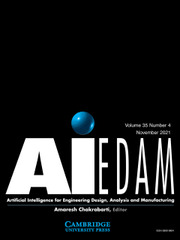Article contents
A self-learning finite element extraction system based on reinforcement learning
Published online by Cambridge University Press: 21 April 2021
Abstract
Automatic generation of high-quality meshes is a base of CAD/CAE systems. The element extraction is a major mesh generation method for its capabilities to generate high-quality meshes around the domain boundary and to control local mesh densities. However, its widespread applications have been inhibited by the difficulties in generating satisfactory meshes in the interior of a domain or even in generating a complete mesh. The element extraction method's primary challenge is to define element extraction rules for achieving high-quality meshes in both the boundary and the interior of a geometric domain with complex shapes. This paper presents a self-learning element extraction system, FreeMesh-S, that can automatically acquire robust and high-quality element extraction rules. Two central components enable the FreeMesh-S: (1) three primitive structures of element extraction rules, which are constructed according to boundary patterns of any geometric boundary shapes; (2) a novel self-learning schema, which is used to automatically define and refine the relationships between the parameters included in the element extraction rules, by combining an Advantage Actor-Critic (A2C) reinforcement learning network and a Feedforward Neural Network (FNN). The A2C network learns the mesh generation process through random mesh element extraction actions using element quality as a reward signal and produces high-quality elements over time. The FNN takes the mesh generated from the A2C as samples to train itself for the fast generation of high-quality elements. FreeMesh-S is demonstrated by its application to two-dimensional quad mesh generation. The meshing performance of FreeMesh-S is compared with three existing popular approaches on ten pre-defined domain boundaries. The experimental results show that even with much less domain knowledge required to develop the algorithm, FreeMesh-S outperforms those three approaches in essential indices. FreeMesh-S significantly reduces the time and expertise needed to create high-quality mesh generation algorithms.
Keywords
Information
- Type
- Research Article
- Information
- AI EDAM , Volume 35 , Special Issue 2: Thematic Collection: Smart Design of Smart Systems , May 2021 , pp. 180 - 208
- Copyright
- Copyright © The Author(s), 2021. Published by Cambridge University Press
References
- 7
- Cited by


